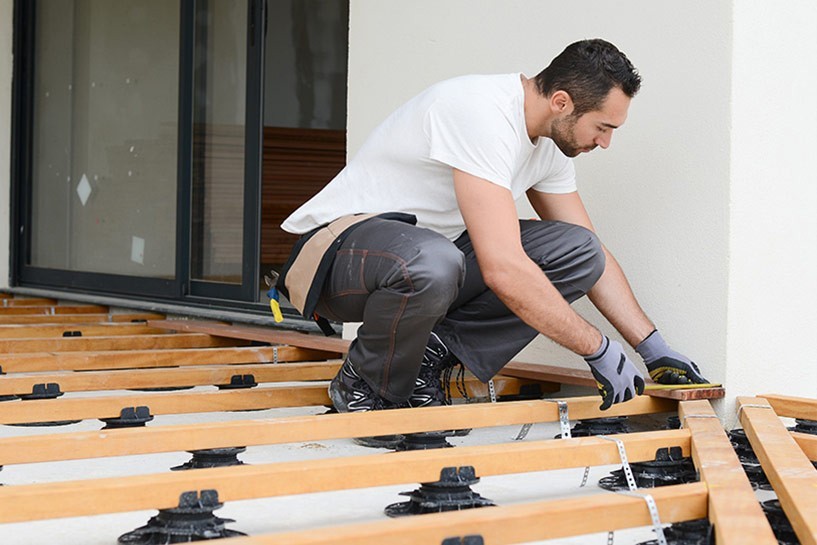A Step-By-Step Guide to Annual Checks On Deck
Decks are a valuable addition to any home, providing a space for relaxation and entertainment. However, to ensure the safety and longevity of your deck, annual checks on deck are crucial. Regular inspections can help identify and address potential safety hazards and maintenance needs before they become major issues. Whether your deck is newly built or has weathered several seasons, professional inspections are highly recommended to ensure it remains in top condition.
Deck Inspection Tools
Before diving into the inspection process, it’s essential to gather the right tools. A thorough checks on deck will require:
– Flashlight
– Measuring tape
– Level
– Screwdriver
– Hammer
– Pry bar
– Moisture meter
– Safety gear (gloves, safety glasses)
These tools will help you accurately assess the condition of your deck and identify any areas needing attention.

Checks On Deck Components
Deck Surface Inspection
The deck surface includes decking boards, railings, stairs, and fixtures. Regular inspection of these areas helps maintain both the appearance and safety of your deck.
Common Surface Concerns:
– Mold and mildew growth.
– Cracking or splintering of decking boards.
– Insect damage.
Substructure Inspection
The substructure is the foundation of your deck, consisting of footings, posts, and joists. This critical component supports the entire structure, making its inspection paramount.
Common Substructure Problems:
– Weathering: Exposure to the elements can cause wood to weaken and deteriorate over time.
– Rot: Moisture can lead to wood rot, compromising the structural integrity.
– Fastener Issues: Loose or corroded fasteners can weaken the connections between structural components.
Footings and Posts
Footings and posts are essential for the stability of your deck. Proper drainage around these components is crucial to prevent water accumulation, which can lead to rot and insect infestations.
Inspection Checklist:
– Check for signs of rot or decay.
– Look for insect infestations.
– Assess for any warping or shifting.
Joists and Framing
Joists and framing provide the primary support for your deck. They must be in excellent condition to ensure the deck’s safety and stability.
Inspection Focus:
– Inspect for rot and insect damage.
– Check for sagging or uneven joists.
– Ensure all fasteners are secure and in good condition.
Flashing and Water Management
Flashing is used to prevent water from seeping into the areas where the deck attaches to the house. Proper water management is crucial to prevent moisture-related damage.
Checking for Issues:
– Look for water stains or signs of water damage.
– Ensure flashing is intact and properly installed.
– Check for loose or missing fasteners.
Guardrails
Guardrails are a critical safety feature, preventing falls from the deck. Regular inspection ensures they remain sturdy and secure.
Inspection Guidelines:
– Check for stability and firmness.
– Look for any damage or wear.
– Ensure proper installation and height.
Deck Stairs
Deck stairs must be safe and stable to prevent accidents.
Safety Considerations:
– Ensure stairs are evenly spaced and level.
– Check for decay or damage to treads and risers.
– Assess overall stability and firmness.
Checks On Different Materials
Composite Decking
Composite decking is a popular alternative to wood, known for its durability and low maintenance.
Features and Maintenance Tips:
– Requires minimal maintenance compared to wood.
– Periodic cleaning with soap and water is usually sufficient.
– Inspect for any surface damage or stains.
Comparison with Wood Decking:
– Less prone to rot, splintering, and insect damage.
– Longer lifespan with less frequent maintenance needs.
Wood Decking
Wood decking offers a natural aesthetic but requires more maintenance to keep it in good condition.
Vulnerabilities and Maintenance Needs:
– Susceptible to water and insect damage.
– Requires regular sealing and staining.
Inspection Checklist:
– Check for water damage and rot.
– Look for signs of insect infestations.
– Ensure proper sealing and stain application.
Professional Deck Inspection
For complex or older decks, a professional inspection is highly recommended. Professionals have the expertise to identify hidden issues and provide necessary repairs.
Benefits:
– Comprehensive assessment of deck condition.
– Expert recommendations for repairs and upgrades.
– Peace of mind knowing your deck is safe and sound.
Conclusion
Maintaining a safe and sturdy deck requires regular inspections and prompt attention to any issues that arise. Annual checks on deck can help you identify potential problems early, ensuring your deck remains a safe and enjoyable space. For complex repairs or older decks, consulting with professionals is always a wise choice. Prioritize your deck’s safety and longevity by staying vigilant with inspections and maintenance.
Trending Reading
What Are the Differences Between the WPC Board and PVC Board?
[2024 Update] How Long Does WPC Decking Last?












